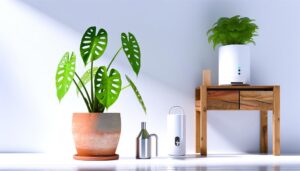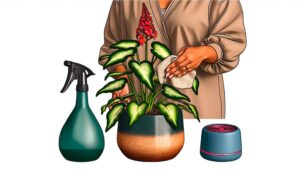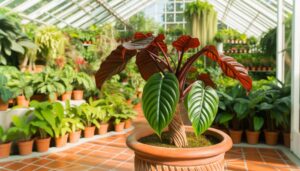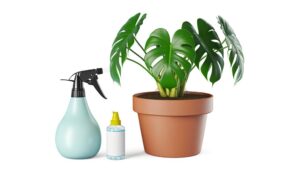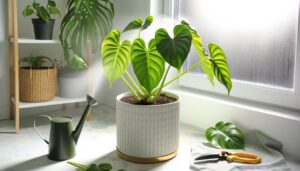Split.Leaf Philodendron Care
Split-Leaf Philodendrons are tropical plants appreciating bright, indirect light, temperatures between 65ºF-85ºF, and high humidity levels (60-70%). Your plant's health depends heavily on a thorough yet balanced watering regime and a well-draining, nutrient-rich soil mix.
Protect it from direct sunlight to avoid leaf damage. Manual removal combined with insecticidal soap can combat common pests like aphids, scale and mealybugs.
Feed your Philodendron a balanced, water-soluble fertilizer every four to six weeks during growing seasons. Regular inspection and adjustments based on the plant's needs are crucial.
Further exploration will reveal more on propagation and advanced care techniques.
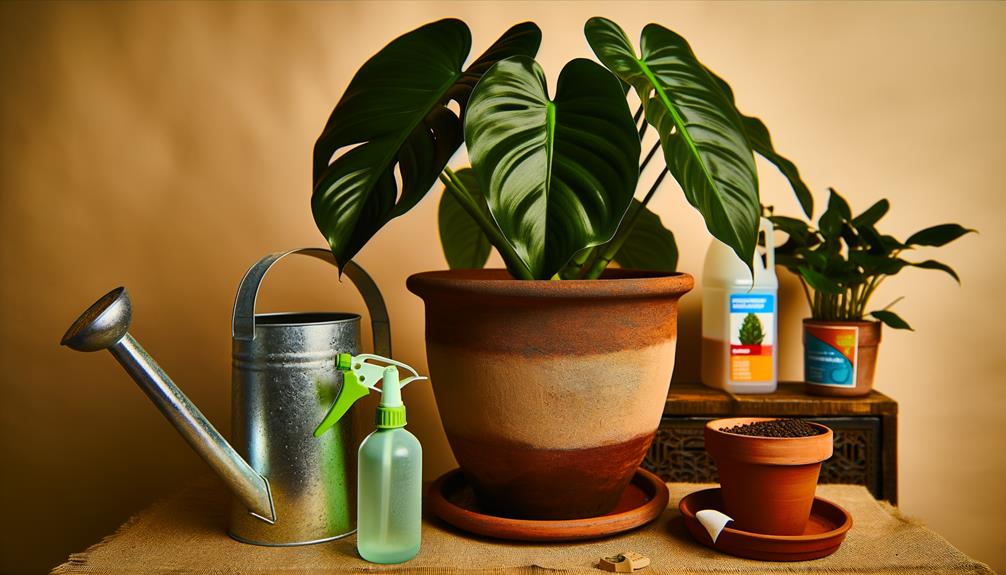
Key Takeaways
- Split-Leaf Philodendron thrives in bright, indirect light and a temperature range of 65°F to 85°F.
- The plant requires moist but not waterlogged conditions, with a risk of root rot if overwatered.
- It is best suited in 60-70% humidity and needs well-draining, nutrient-rich soil with a slightly acidic to neutral pH.
- Fertilize with a balanced, water-soluble formula every 4-6 weeks in spring and summer and control pests like aphids and mealybugs.
- Propagation can be achieved through methods like stem cuttings, air layering, division, leaf bud cuttings, or water propagation.
Understanding Split-Leaf Philodendron
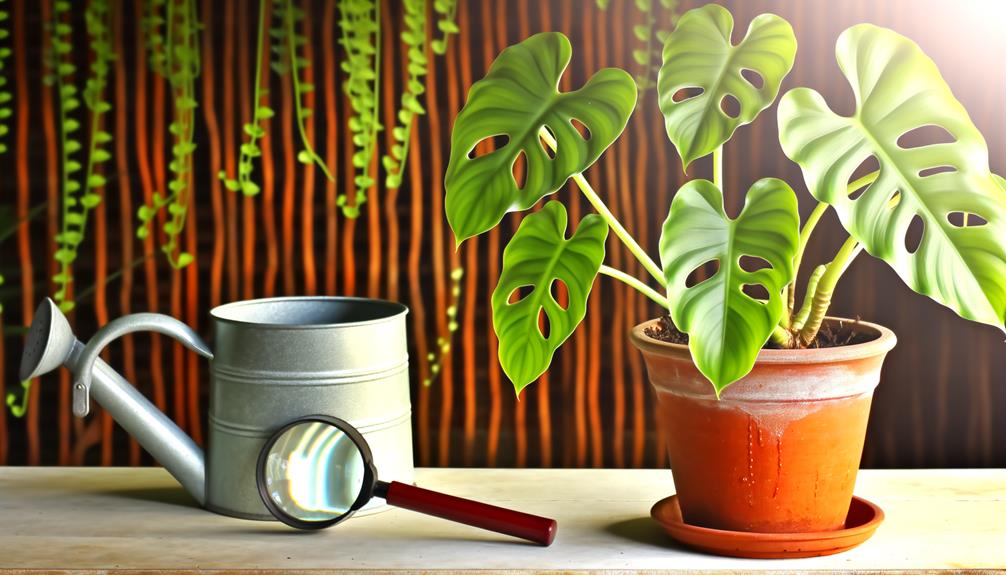
The split-leaf philodendron, scientifically known as Monstera deliciosa, is a tropical plant native to Central America, renowned for its unique, large, perforated leaves that have earned it a place of prominence in the world of indoor horticulture.
It thrives best in a warm, humid environment, resembling its native habitat. The plant's epiphytic nature means it benefits from a well-draining soil mix, mimicking the forest floor conditions where it would naturally grow.
Additionally, its aerial roots, which would anchor it to tree trunks in the wild, can be utilized for support in cultivation, allowing it to scale upward. Understanding these characteristics is key for anyone desiring to provide exceptional care and create an ideal environment for the split-leaf philodendron's growth and longevity.
Ideal Lighting Conditions
Mastering the art of providing perfect lighting conditions proves essential for the growth and health of your split-leaf philodendron. These tropical plants thrive best in bright, indirect light, although they can tolerate low light conditions.
Exposure to direct sunlight can scorch their large, glossy leaves, causing irreversible damage. Ideally, east or north-facing windows provide the most suitable lighting conditions. If indoor lighting is insufficient, consider using fluorescent lights to supplement natural light.
Placement is also important: a distance of 5-8 feet from the window strikes a balance between too much and too little light. Analyzing and adjusting lighting conditions as needed will ensure your philodendron remains healthy and continues to thrive.
Watering Techniques and Tips
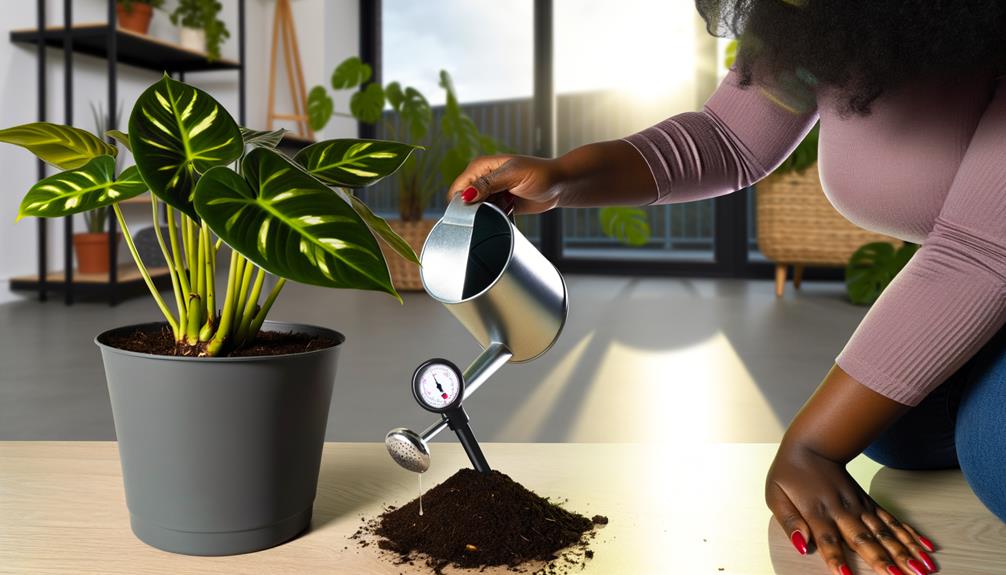
Watering your split-leaf philodendron demands precision and careful attention, as these tropical plants thrive in moist but not waterlogged conditions. Overwatering can lead to root rot, a common issue that can severely damage or even kill your plant.
The ideal watering technique involves slowly pouring water into the pot until it starts to drain from the bottom. This guarantees the soil is thoroughly moistened without becoming waterlogged. A top tip is to check the soil's moisture level before each watering. If the top inch of soil is still damp, delay watering until it dries out.
This approach, combined with a high-quality potting mix that drains well, will help your split-leaf philodendron flourish and minimize the risk of overwatering.
Humidity and Temperature Needs
The Split.Leaf Philodendron flourishes best in specific humidity and temperature conditions. To guarantee the plant's peak health, understanding the ideal humidity levels and best temperature ranges is essential.
Consequently, mastering how to adjust these climate conditions efficiently within your indoor environment can greatly aid in the thriving growth of your Split.Leaf Philodendron.
Ideal Humidity Levels
In the realm of indoor gardening, maintaining the ideal moisture levels for your Split.Leaf Philodendron is a significant aspect of its care routine. This plant thrives in damp environments, with the best moisture level ranging between 60% and 70%. Such conditions mirror the plant's tropical origins and help optimize its healthy growth.
Sub-par moisture can result in wilting and brown leaf tips, signaling plant stress. To uphold these levels, consider investing in a hygrometer to monitor indoor moisture. Regular misting, placement of a water-filled pebble tray under the pot, or using a humidifier can also effectively increase moisture.
It's essential to understand that each plant has unique needs and successful indoor gardening involves catering to those with accuracy and commitment.
Optimal Temperature Ranges
Maintaining your Split.Leaf Philodendron's comfort is essential to sustain a comfortable temperature range between 65°F and 85°F, reflecting the plant's tropical heritage. This range emulates the plant's native environment and encourages optimal growth.
Consider the following factors when gauging temperature needs:
- *Seasonal changes*: During winter, temperatures can drop below this range. Make sure indoor heating isn't too dry.
- *Location of the plant*: Avoid placing it near heat sources like radiators or vents.
- *Sunlight exposure*: Direct sunlight can lead to overheating, choose bright, indirect light.
- *Room temperature fluctuations*: Be mindful of sudden changes that could shock the plant.
- *Indoor vs. outdoor plants*: Outdoor plants may require additional protection during cooler months.
Providing the right temperature range is part of responsible plant care, promoting health and longevity.
Adjusting Climate Conditions
While maintaining the necessary temperature range is crucial, equal attention must be given to the humidity levels and adjustments in climate conditions, as these factors greatly impact the health and growth of your Split.Leaf Philodendron.
This tropical plant thrives in humid conditions, ideally between 60% and 80%. You can increase humidity by placing the plant on a tray filled with pebbles and a bit of water, or using a humidifier.
When it comes to temperature, keep it consistently between 65-75°F, avoiding any sudden fluctuations. Too low or high temperatures can cause leaf browning or yellowing.
Regular monitoring and swift adjustments to these parameters will guarantee your Split.Leaf Philodendron remains vibrant and healthy.
Choosing the Right Soil

Selecting the perfect soil blend for your Split.Leaf Philodendron is a critical aspect of its care, with a nutrient-rich, well-draining mix often being the most suitable choice. The ideal soil composition guarantees the plant's roots absorb essential minerals efficiently while preventing waterlogging, promoting healthy growth.
Consider the following factors when choosing soil for your plant:
- Drainage properties: A mix that drains well to prevent root rot.
- pH Level: Philodendrons prefer slightly acidic to neutral pH levels.
- Organic matter content: A high percentage of organic matter to supply nutrients.
- Texture: Loamy soil is ideal as it balances moisture retention and drainage.
- Soil fertility: It should be rich in essential minerals like nitrogen, potassium, and phosphorus.
Choosing the right soil is a proactive step towards securing your philodendron thrives.
Fertilizing Your Philodendron
Proper fertilization is an essential aspect of Split.Leaf Philodendron care, requiring a thorough understanding of the plant's nutritional needs and the best timing for application.
This tropical plant thrives best with a balanced, water-soluble fertilizer (20-20-20) applied every 4-6 weeks during its growing season—spring and summer. However, it's important to reduce fertilization to every other month in the fall and winter, as the plant's growth slows.
Over-fertilization can lead to salt build-up, causing leaf burn. Always water your philodendron before fertilizing to avoid root burn.
Pruning and Repotting
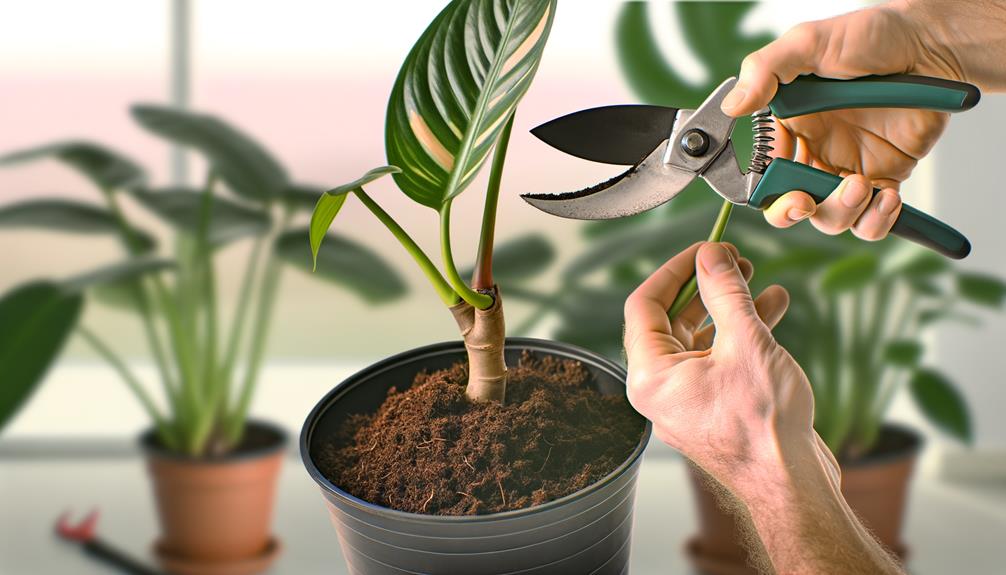
Pruning and repotting are integral parts of Split.Leaf Philodendron care, requiring a methodical approach for best plant health and growth. These tasks should be undertaken with care and precision to make certain the plant thrives.
Here are some key points to keep in mind when pruning and repotting:
- Always use sterile, sharp tools for pruning to prevent disease transmission.
- Prune during the growing season, typically spring or early summer.
- Repot when roots become visible at the pot's surface or drainage holes.
- Choose a pot that is 2 to 4 inches larger in diameter than the current pot.
- Use a well-draining potting mix suitable for philodendrons.
Identifying and Treating Pests
In the world of Split.Leaf Philodendron care, the identification and treatment of pests are critical procedures to guarantee the best health and longevity of the plant.
Common pests include aphids, scale, and mealybugs, which can be identified by curling leaves, yellowing foliage, and sticky residues.
Effective treatment often involves a two-pronged approach: manual removal and the application of a mild insecticidal soap. Manual removal includes wiping off the pests with a damp cloth or gently rinsing them off under a soft stream of water.
Insecticidal soaps are safe for the plant but harmful to pests, ensuring the plant's health is not compromised.
Regular inspection and prompt action are key in maintaining a thriving Split.Leaf Philodendron.
Propagation Methods and Tips
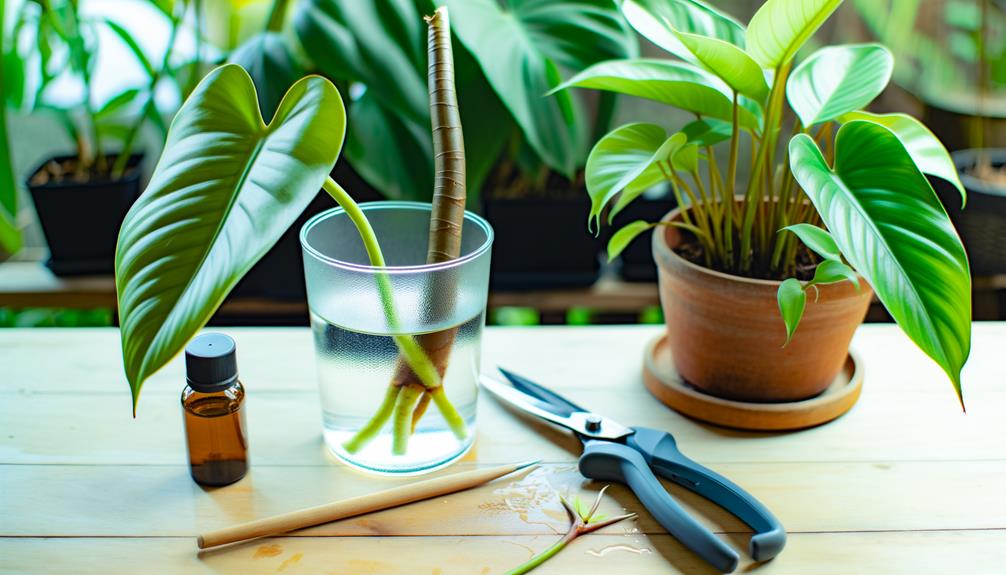
Moving from pest control to another crucial aspect of Split.Leaf Philodendron care, propagation methods and tips offer techniques to multiply these striking plants and ensure their continued growth.
As a grower, you have a responsibility to contemplate these majestic foliage plants continue to thrive.
Here are some propagation techniques to ponder:
- *Stem Cuttings:* Cut a 6 inch stem right below a node, dip in rooting hormone, then plant in moist potting soil.
- *Air Layering:* This method stimulates root growth on the stem while still attached to the mother plant.
- *Division:* Divide a mature plant into several smaller ones during repotting.
- *Leaf Bud Cuttings:* Cut a leaf with an attached bud, plant it in soil and wait for it to root.
- *Water Propagation:* Submerge the cut end of a stem in water until roots form, then transfer to soil.
Each method has its benefits and potential challenges, choose wisely according to your specific needs.
Conclusion
To conclude, split-leaf philodendron care demands comprehension of the plant's innate characteristics and requirements. From proper lighting conditions, watering methods, soil selection, to pest control, every aspect is crucial for its flourishing development.
As we have observed, isn't it impressive how a bit of focus on specifics can secure the thriving presence of these luxuriant green beauties?
Therefore, with the correct knowledge and methods, one can truly become a triumphant split-leaf philodendron caregiver.

